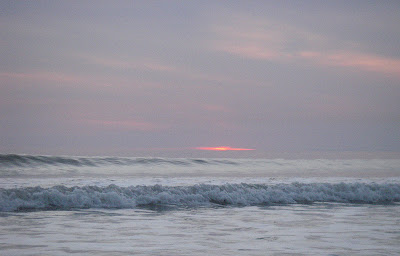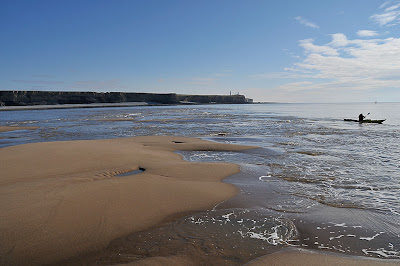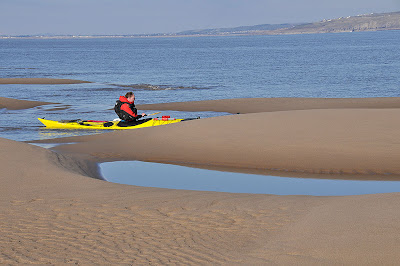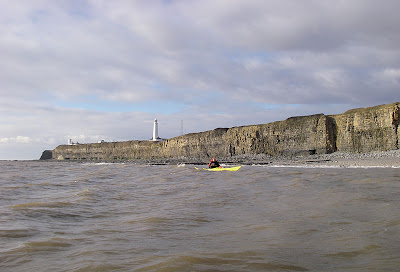 |
| Setting out from St Donats |
The proposition was to just ride the Severn tide down for most of the day and back again, just to see what happened. Richard was interested. So we left St Donats with approx. 3 hours left of the ebb.
To add a little interest and to break up the monotony a bit we came up with the idea of following a line of cardinal buoys that seemed to have been placed in a perfect position just for the job, that also led us to a fairly large sand bank (nice place to stop for a bite to eat we thought).
 |
| Heading past East Nash along the Glamorgan Heritage Coast |
 |
| East Nash Cardinal taking the strain at Nash Sound |
Sticking our noses out towards Nash Point we are making a good 5 knots towards the Sound without dipping a paddle in. We clock up about 8 knots as we paddle past the East Nash Cardinal.
Next up is the Mid Nash South Cardinal.
 |
| Richard a few miles offshore at the Mid Nash South Cardinal |
 |
| Mid Nash South Cardinal |
Richard spots a single gannet up in the sky, and then below it a porpoise.
We sit and watch as it trawls for fish.
Magic to watch.
 |
| Porpoise trawling the Bristol Channel |
 |
| West Nash Cardinal |
 |
| South Scar Cardinal at Scarweather Sands |
This is where we had planned to stop for our lunch. There is no sand bar to be seen. We have made good time and the tide has not turned yet. We see plenty of waves breaking over the sand bank and decide to take a closer look.
 |
| Seeing some interesting rough water we decide to head over to the waves breaking over the sand bank |
Some very tasty waves are seen and we have a little play in the rough water.
 |
| Surf spot some 5 nautical miles offshore - no boardies out here to drop in on |
I can only imagine that this spot must be the gateway to some neptunous hell on a rough day! Some 100m further on and all is back to an oily flat calm sea . . .
Given the good time we have made and we still have an ebbing flow, we decide to continue on towards the West Weather Cardinal.
 |
| West Scarweather |
 |
| The Ledge South Cardinal - time to go home |
With all the sights taken in, we don't bother to stop on the way back. Just make a B-line for Nash Point.
 |
| Passing Nash Point lighthouse before the final slog around to St Donats |
For what could be regarded by most as a pointless boring paddle, this has been quite an amazing days paddle.
37 nautical miles (69 km) covered in just over 7.5 hours - channel riding at its best!
 |
| 69 km round trip |










































